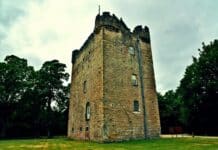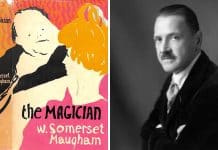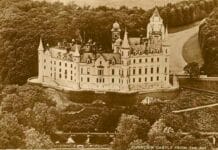MJ STEEL COLLINS looks at the fascinating tale of Isobel Gowdie, a Scottish woman tried for witchcraft in 1662
The case of Isobel Gowdie, or Goudie, is one of the most intriguing in the history of Scottish witchcraft. Her impact on popular culture is considerable; she has influenced literature and music, with several songs, literary works and even an orchestral piece created in her name. Perhaps that Alex Harvey, renowned front man of The Sensational Alex Harvey Band wrote a song, Isobel Goudie, is not too surprising given he apparently had an excellent knowledge of Scottish folk tales.
“She Does Not Do The Things She Should”
His song captures the essence of Isobel Gowdie’s tale well, of a woman falling for the dark side. Gowdie was born sometime in the early 1600s in Auldearn, a village just outside Nairn in the Scottish Highlands. The daughter of a solicitor, she was a highly educated woman, encountering the upheaval of the Covenanting War in her youth, probably witnessing the gory Battle of Auldearn in 1645. She found herself trapped in a fairly miserable marriage. Sources say she married ‘beneath herself’, to John Gilbert of Lyon, a farmer and Kirk elder, going to live at his farm in Lochloy. The farm was isolated, and Isobel cut a lonely figure, expected to accompany her dour husband everywhere he went, which she was reluctant to do. Arguably, it was this dreich existence that drove her to witchcraft.
Gowdie is a pretty unusual character in the history of witch persecution. When she made her confession in 1622, she made it freely, without torture. There is no record of her being executed, or of her subsequent life, if she lived. Historian Emma Wilby discovered the original documents of Gowdie’s detailed confession, which formed the basis of her 2010 book Visions of Isobel Gowdie: Magic, Shamanism and Witchcraft in Seventeenth-Century Scotland. The documents were subject to verification by the National Archives of Scotland.
Auldearn Kirkyard
Gowdie’s venture into witchcraft began when she met Margaret Brodie, who foresaw that she would meet Isobel in the Kirkyard at Auldearn church; Margaret subsequently taught Isobel a lot about the dark arts. It was on her way home from that first meeting with Margaret Brodie that Gowdie first met the Devil on the Drumduan Road. He offered Isobel an alternative to her dull life, promising to show her true power. He also predicted, like Brodie, that he would meet Isobel in Auldearn Kirkyard. As further proof of his powers, Satan told Isobel that the farm at Mains of Culbin would be destroyed. The next day, she awoke to find that the farm had been lost under a huge sand drift, destroying its harvest.
The predicted meeting at Auldearn Kirkyard went ahead, with Isobel meeting both the Devil and Margaret Brodie. At this meeting, Isobel was renamed “Jonet” by the Devil and received his mark. From then on, she went on to fairly big things in the witching world. She was the powerful head of her own coven, which, according to her confessions, got up to all types of magic. Interestingly, her confessions, which had a huge impact on Scottish witchcraft, introduced the word coven into the general lexicon of witch trials.
Gowdie, in her confession, described how she and her coven were able to shape shift, turning into creatures such as hares. The incantation they used was:
“I shall go into a hare,
With sorrow and sych and meickle care;
And I shall go in the Devil’s name,
Ay while I come home again”
And to change back:
“Hare, hare, God send thee care.
I am in a hare’s likeness now,
But I shall be in a woman’s likeness even now.”
Apparently a similar incantation continues to be used today in modern neo-pagan witchcraft.
Isobel Gowdie, Lady of the Night
As well as this, Gowdie became the Devil’s consort, consummating their relationship under a tree in Auldearn Kirkyard. She spent a lot of time with her satanic lover, usually substituting herself with a besom or double to accompany her husband as he went about his business. Isobel also became acquainted with the Queen of Elfhame in the faerie world, visiting her halls. Local farms were a favourite target of Gowdie’s. She would destroy their crops and other produce with her spells.
But perhaps her favourite target was the Laird of Lochloy and Park, her husband’s landlord. The Laird had made sexual advances towards Isobel, which she rebuffed. After that, he spoke of her derogatorily, and slandered her to the minister for Auldearn, Harry Forbes. The Laird also refused to carry out repairs around her husband’s farm. In return, Gowdie cursed the Laird’s family, that none of their male children would survive into adulthood. Sure enough, all the Laird’s existing sons died, and subsequent male babies never made it beyond six months. Harry Forbes was another target, but he survived and was present at Isobel’s confession.
It’s not clear what made Isobel Gowdie confess to witchcraft during a period of panicked frenzy about witches. She may have been in a trance or suffering a psychosis. Emma Wilby argues that the confessions point to visionary shamanic traditions, and belief in witchcraft in conjunction with faerie belief in the early modern era. That aside, at the time, what the interrogators were looking for at the time was evidence, of diabolic, nefarious doings. And with Isobel Gowdie, they got it.
Isobel Goudie, by The Sensational Alex Harvey Band, can be heard below.








[…] Read more from Mandy on the story of Isobel Goudie here. […]